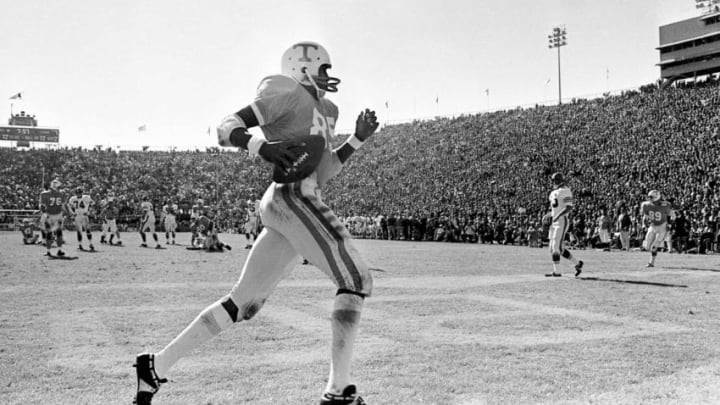Like the rest of the SEC and sports in general, Tennessee football has a complicated history when it comes to issues of race and sexual orientation. However, one tradition of Rocky Top has been to always blaze trails on those things, and Danny White seems to understand that.
The Vols will now to honor such trailblazers. On Friday, UT announced that status honoring Lester McClain, Jackie Walker, Condredge Holloway and Tee Martin will be unveiled outside Neyland Stadium when the program opens the season on Sept. 2 against the Bowling Green Falcons. This is part of an overall year-long celebration of the 100-year anniversary of the stadium.
All of these icons show just how much of a groundbreaking program Tennessee football was. The Vols shattered glass ceilings in a way few, if any SEC teams, and at least three of these statues prove that in a huge way.
McClain, who played wide receiver for the Vols from 1968 to 1970. He was the second Black player in SEC history. The first was Nate Northington of the Kentucky Wildcats. However, Northington only played three minutes in one game in 1967 and then transferred at the end of the year to the Western Kentucky Hilltoppers.
On the other hand, McClain scored the first touchdown by an African American in SEC history and was a key part of Doug Dickey’s program, later taken over by Bill Battle, during that time. He led the Vols to an SEC title in 1969 and helped them go 11-1 with a Sugar Bowl win and top five finish in 1970.
Joining McClain as a teammate for two of those years was another trailblazer in a different way. Jackie Walker, who played linebacker for the Vols from 1969 to 1971, was a two-time All-American. In 1971, he became the first Black captain of an SEC team.
Walker stands out in a bigger way, though. He was an openly gay player. It’s very rare for players to come out now, 50 years later, at any level. Imagine what it was like for Walker in the late 1960s and early 1970s, when the SEC was barely beginning to integrate racially.
There is reason to believe Walker’s sexual orientation kept him from having an NFL career. However, he broke ground on both fronts for the SEC, and he’s arguably the biggest icon for Tennessee football when it comes to that. Walker, who passed away in 2002, has always been criminally overlooked as a star for the Vols. His statue is long overdue.
More from Vols Football
- How to Win a GUARANTEED $200 Bonus Betting Just $5 on the Vols vs. Florida!
- Tennessee Football at Florida: Five Keys to a Vols Victory
- Week 3 SEC Power Rankings: Did Tennessee Football’s Win Help At All?
- Week 3 AP Polls: Why Did Tennessee Football Drop in the Polls?
- Tennessee Football: Top Five Performers in 30-13 Win vs. Austin Peay
UT having Walker and McClain on the team at the same time would be trailblazing enough. However, Battle then continued breaking ground for the Vols by starting Condredge Holloway the next year. Holloway became the first Black starting quarterback in SEC history and led UT to three straight bowl seasons with top 25 finishes, most notably a 10-2 and top 10 season in 1972.
It was unfortunate that Holloway joined a program that was beginning to fade. The Vols had fallen behind the times on some other key aspects, including facilities and stadium upgrades, and as the rest of the SEC integrated, that left them in a bad place when Holloway left.
Two years later, Johnny Majors began the process of rebuilding the program, and that culminated with what Phillip Fulmer and Peyton Manning were able to do in the mid-1990s. However, the final statue of this group completes the story.
Martin committed to Tennessee football over numerous Alabama schools in 1996. Two years later, he was given the daunting task of replacing Manning, easily the greatest player in the history of the program. Well, we all know the story. Martin became the first Black SEC quarterback to win a national championship, leading the Vols to a 13-0 record.
If you’re keeping score, Tennessee football had the first African American to see significant action in SEC play, the first African American to be a captain of an SEC team who was also openly gay in the 1960s and 1970s, the first African American starting quarterback in the SEC and the first African American quarterback to lead an SEC team to a national title. That’s impressive.
By the way, we haven’t even talked about how the athletic department as a whole led the way when it comes to gender equality. Pat Summitt and the Lady Vols programs could fill a book on their own. Simply put, this school’s success is built on shattering glass ceilings and breaking down barriers of all kinds.
Honoring these four guys with statues is a great step towards recognizing what the program stands for. White clearly understands that while traditions are important, UT built itself up by breaking ground and getting ahead of the curve. He’s clearly thinking about that going forward now, and remembering these players from the past is a great way to do that.
